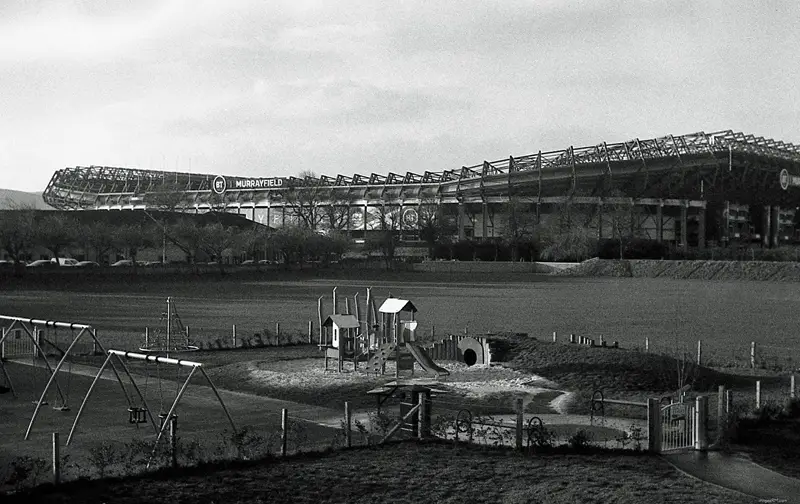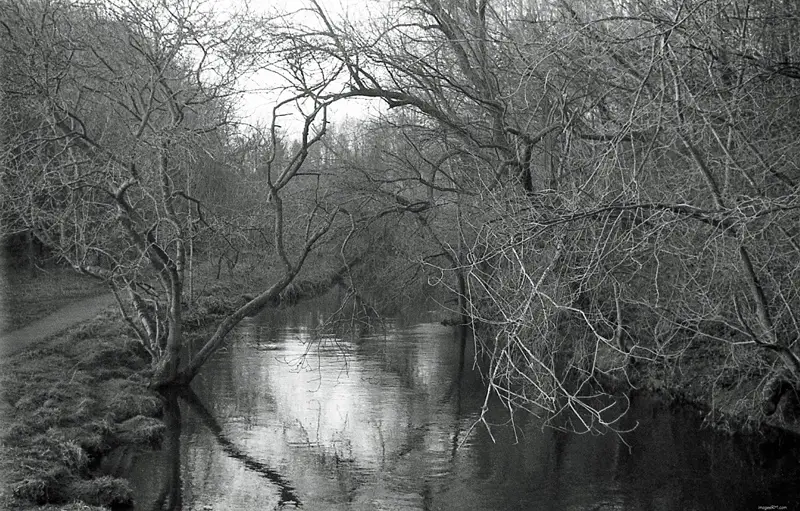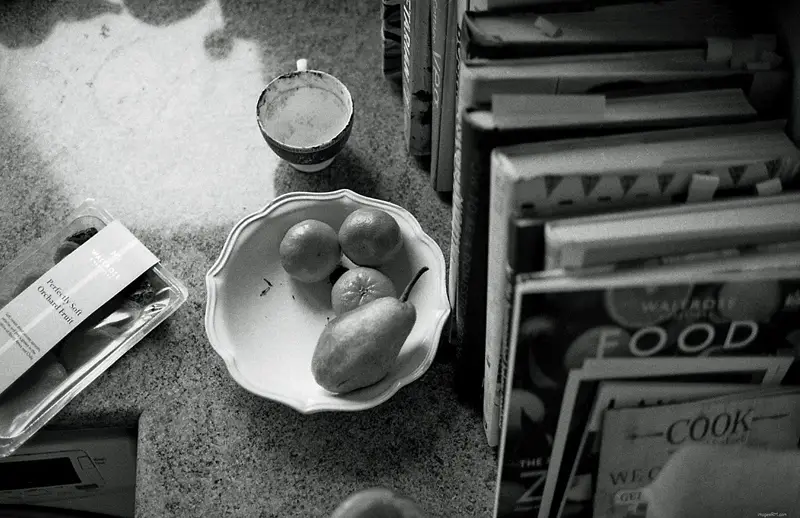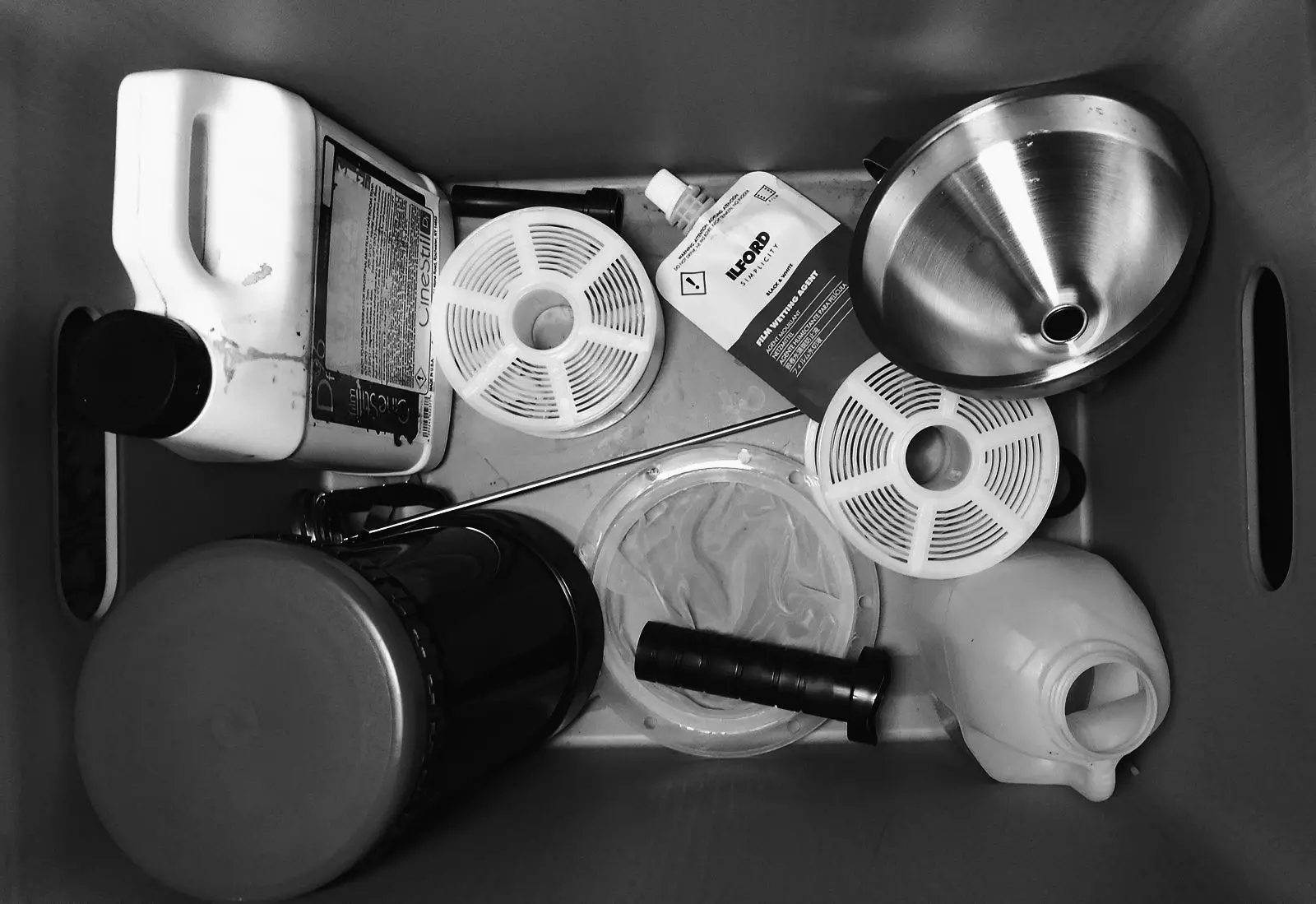I’d been shooting film alongside digital for about a decade, and once took a course in b&w film developing. Unfortunately, I suffered an allergic reaction to the chemicals, which induced a major asthma attack. I was bitterly disappointed with the experience and put to the back of my mind any thought of ever developing my own film at home.
Well, recently I saw a video of someone using Cinestill’s Df96 Monobath, which requires only a three-minute development, is pretty much odourless, and offers a much more user-friendly experience. I wondered if I would have the same reaction, but reasoned that if I could get the film into the developing tank, then I could use the chemicals outside in the fresh air.
So, I took the plunge, ordering not only the monobath but all the necessary paraphernalia to go with it: AP tank with two reels, thermometer, dark bag, spool opener, funnel, wetting agent for the final wash, etc. I watched a few videos, and convinced myself that I could do this.
Well, things didn’t quite go to plan, but I do feel I have achieved something I can now work with. Here’s the story of my first three reels, first three attempts…
Reel 1
I practised getting an old film onto the AP reels, and the reason I chose them instead of Patterson reels is that they have a lip to help guide your film onto the reel. I had instant success with eyes open, eyes closed, and in the dark bag. I highly recommend these reels!
I had just finished shooting a roll of Ilford’s Delta 400, and full of misguided confidence decided to jump ahead and use this reel for my first development. I have to say it was a partial success, partial failure.
Here’s the good news:

…and the bad:

But first, the process:
I warmed the tank (with film in place) with water matching the temperature of the developer, 80F/27C, poured it out after a few minutes, then poured in the monobath. One video from a lab technician at Emulsive recommended not doing the inversion technique, instead agitating by turning the stick in the centre of the tank. He suggested four turns forward, four back, for three minutes. I then poured the monobath back into its bottle, and washed the film for ten minutes.
As soon as I hung the film to dry, I could see a streak across the central ten or so shots. Having no experience of this before, I looked online for advice. Most people said the fixative in the monobath was not working as it should, and I should add some fixative, and wash it out again. Well, I didn’t have any fixative, just the monobath. As most of the negatives looked okay, I decided to just leave as is, and accept my loss. At this stage, I was not too happy with the Cinestill monobath! I hasten to add that I was too quick to blame the developer.
I was pleased with many of the shots, though they had more grain than I was used to seeing with Delta 400, but the sensitivity I was seeking in that first shot above was just what I had hoped for. However, the light streak seen in the second image had me doubting the whole process.
Reel 2

This time I decided to use the inversion method of agitation in the belief that the rotating stick version did not allow the monobath to reach the whole film. The result was a complete film of images, but with a catch. After initially warming the tank again, I added the monobath, but for some stupid reason I had forgotten to empty the warm water first. Suddenly there was a mixture of monobath and water overflowing the tank – and the clock was running! I quickly emptied the mixture, and poured in the remaining monobath, for which there was just enough left to cover the reel. In my panic, I couldn’t calculate how much time the monobath should be active. With each subsequent use of the monobath you are required to add fifteen seconds of development time, and I added another 30 seconds for the mishap. Wrong, I should have subtracted 30 seconds!
The result is that the film was overcooked. But on a positive note, I accidentally discovered how to push-process!
The film was Ilford HP5, which thankfully has a lot of latitude – useful for numpties like me! The negs were grainy and the contrast was very high. In Lightroom I reduced Contrast a little, and suddenly the images were acceptable, some more than others.


Reel 3
This time I got smart, and decided to shoot 36 random shots around my house, without any thought at all for composition – I just wanted to practise developing.
Since my first two efforts I had been advised that Ilford do NOT recommend a pre warm-up wash, so I went straight in with the monobath. I used the inversion agitation technique again, and added another fifteen seconds – now 3’30” – for development, before washing the film out, and hanging to dry. The film immediately looked more successful.

This looks more “normal” for HP5. I like the grain level, and there is enough tonality there to play with (if I had wanted to) in Lightroom. The whole film looks acceptable. I’ve chosen to share this particular shot as it accidentally looks composed, yet was no more composed than any of the 35 other shots taken within five minutes that day. Don’t be alarmed, that cup is used for watercolour paint, not tea!
Conclusion
It helps not being a numpty! I made mistakes with my first two attempts, but now have my technique down: no warm up, just the monobath for three minutes (plus fifteen seconds for each subsequent development) and a ten-minute wash. I leave the film to dry overnight.
I have had no breathing problems, no asthma attacks, and I can carry out the whole process in the bathroom. And there is no smell 🙂
The Cinestill Df96 makes home developing so much easier than the traditional method, though seasoned traditional developers will find this hard to fully accept, and quite naturally will stick to their tried and tested methods. But for anyone wanting to get into home developing but who is (like I was) a bit nervous about the whole procedure, the monobath method from Cinestill works really well. In the future I might explore a more traditional method, but for now I am happy with how this works for me. Sure, I’ll refine the process over time, but I have a working method which is easy.
It couldn’t be simpler: add monobath, agitate by inversion, wash and dry.
I now know how to get normal and pushed results with Delta and Plus films from Ilford, and as I rarely use anything else, I am happy to stick with what works. My understanding is that some films work better with Df96 than others. See the Cinestill website for details.
One negative is that the developer has a fairly short working life, so once opened you have four to six weeks in which to get the best out of it, in which time it will take up to 16 rolls. Now, that’s a lot of rolls per month! So you will either be encouraged to shoot a lot more film, or you should save up a dozen or so films before opening a new bottle. It also comes in powder form for dilution.
Seriously, if I can do it, you can too! Just (ahem) don’t start with your best shots!
Rob MacKillop
Share this post:









Comments
Andrea Bevacqua on Learning to develop film with the Cinestill Df96 Monobath – By Rob MacKillop
Comment posted: 07/04/2020
As a newbie, I started with Cinestill and I find it very easy...I mean, easier than making all the combinations of various liquids in order to develop a roll.
As you very well described, it is easy to obtain a result but of course it takes a bit of care to obtain a good result.
For me, this mono bath, is a thumb up!
Cheers,
Andrea
Comment posted: 07/04/2020
Terry B on Learning to develop film with the Cinestill Df96 Monobath – By Rob MacKillop
Comment posted: 07/04/2020
Out of general interest, I followed up your post with finding out what others thought about it, and from one of the only UK stockists that seem to have stock, is the following comment:
"Works with any black and white film, and is designed for traditional cubic-grain emulsions with high silver content, like BwXX and Tri-X. Tabular grain, high speed and specialist films will require different processing and ISO rating – refer to the data sheet under Other Information.
Native ISO development:
27°C for at least 3min : constant agitation
24°C for at least 4min. : intermittent agitation
21°C for at least 6min. : minimal agitation
*Below 20°C renders pulled contrast negatives
Temperature tolerance /- 1°C"
You may find the development criteria interesting, and no mention of a pre-soak bath.
Decades ago, there was a monobath dev/fixer on the market, but it never proved that popular. Photographers wanted more control over film/developer combinations.
Comment posted: 07/04/2020
Jack on Learning to develop film with the Cinestill Df96 Monobath – By Rob MacKillop
Comment posted: 07/04/2020
Comment posted: 07/04/2020
Floyd K. Takeuchi on Learning to develop film with the Cinestill Df96 Monobath – By Rob MacKillop
Comment posted: 07/04/2020
I'm shooting mostly Arista Edu Ultra 100 for 4x5, and find that film benefits from a prewash to get the dye out. I live in Hawaii, and have found that using the developer at room temperature (about 71 degrees F) is fine. I'm finding development times of about 6-7 minutes results in a good negative. I don't do much agitation.
So far I've developed the Arista (which I believe is rebranded Fomapan 100), and a couple rolls of Tri-X 120 and 135. I've got film holders loaded with CatLabs 80 4x5, so we'll see how it does in the monobath. Overall, though, I've found it pretty forgiving.
I decided to go this route mainly to use it in when I travel. I'm incorporating 120 and 4x5 along with digital into a couple of large documentary commissions I've got in Oceania. I'm hoping I can soup the film at night by taking the DF96 in powder form, a couple of 1 liter bottles, a processing tank, and a hanging system to dry the film in the bathroom. Now if I can also rig a digital camera "scanning" system, I'll be in business.
Comment posted: 07/04/2020
Andrew Lossing on Learning to develop film with the Cinestill Df96 Monobath – By Rob MacKillop
Comment posted: 07/04/2020
- Adding extra time for the mishap with the pre-soak: if you read carefully through CineStill's info on DF96, you'll see that adding extra development time does NOT increase development. The temperature is the only thing which affects development strength. The agitation is the only thing which affects fixing. DF96 is basically balanced between developer and fixer with the chosen temps and agitation strength being what biases your negatives one way or the other.
- Delta 400 recommends twice the development time. So, instead of 4 minutes, you would do 8. In regards to the uneven development you're seeing, I think maybe the spinning agitation was too hard, but I don't really know what caused that. My roll processed so far of Delta 400 came out quite even.
My tips so far on DF96 are that it handles pushing one stop quite well, with temps around 80 degrees. HP5 shot at 800 and pushed one stop look really nice. Pushing two stops (higher temps) have been hard to get good results, probably because I haven't used a warm bath for the whole thing, so temps decrease during development. I also haven't been super impressed with the minimal agitation method - results are best smack in the middle. Middling temps, middling agitation, pushing no more than 1 stop. Your mileage may vary.
Comment posted: 07/04/2020
James Evidon on Learning to develop film with the Cinestill Df96 Monobath – By Rob MacKillop
Comment posted: 07/04/2020
Comment posted: 07/04/2020
Comment posted: 07/04/2020
Marc Wick on Learning to develop film with the Cinestill Df96 Monobath – By Rob MacKillop
Comment posted: 08/04/2020
Keep on going!
Comment posted: 08/04/2020
Comment posted: 08/04/2020
Huss on Learning to develop film with the Cinestill Df96 Monobath – By Rob MacKillop
Comment posted: 08/04/2020
It has inspired me to order up the gear so I can dev at home too. With my local camera Store/film processor being shut down over the Covid, it seems a good time to roll my own so to speak!
Be well.
Huss
Comment posted: 08/04/2020
Comment posted: 08/04/2020
Eric Norris on Learning to develop film with the Cinestill Df96 Monobath – By Rob MacKillop
Comment posted: 10/04/2020
With labs either closing down or extending the time it takes to process film, I've also decided to try CineStill's two-step color process. Chemicals should arrive soon, and I have a couple of rolls of color ready to go. If it works, it will be great--I calculate the cost of chemicals at about $1 per roll, compared to $10-11 for processing at a lab. I'll scan the negatives at home on my Epson V550.
Comment posted: 10/04/2020
Matt Chmielecki on Learning to develop film with the Cinestill Df96 Monobath – By Rob MacKillop
Comment posted: 26/08/2020
Of note- I was amazed to find that you are “The Rob MacKillop”, in fact a favorite musician and author of mine! I am a regular viewer of your YouTube channel and huge fan of your work. I have seen your photos before but I was surprised to see the name upon Googling reviews of CineStill Monobath, and more surprised still to find you are the same Rob MacKillop. Small world, indeed. Thanks for all you do.
Comment posted: 26/08/2020
Amigo toro on Learning to develop film with the Cinestill Df96 Monobath – By Rob MacKillop
Comment posted: 25/10/2021
Alex on Learning to develop film with the Cinestill Df96 Monobath – By Rob MacKillop
Comment posted: 26/10/2021
Jerome on Learning to develop film with the Cinestill Df96 Monobath – By Rob MacKillop
Comment posted: 20/01/2022
I’ve found df96 to have a longer shelf life than Cinestill states. So far, I’ve used two batches of Df96 one pre-mixed and a second mixed from powder using distilled water. The pre-mixed batch lasted for 10 months. The powder batch I mixed in 05/21 and just developed rolls 8 and 9 last week, 01/22, and it was only mildly discolored. So, I’m fairly confident it’s good for at least 8 months if kept air-tight.
Developer Review Blog No. 32 – Cinestill Df96 – Alex Luyckx | Blog on Learning to develop film with the Cinestill Df96 Monobath – By Rob MacKillop
Comment posted: 29/08/2022
Harold Eastman on Learning to develop film with the Cinestill Df96 Monobath – By Rob MacKillop
Comment posted: 24/05/2023
Comment posted: 24/05/2023